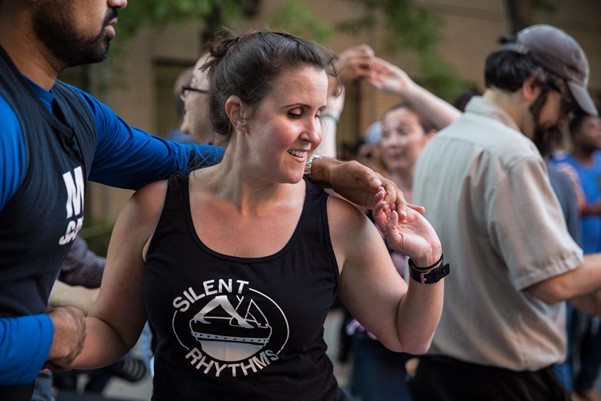
Kerry Thompson, Founding Executive Director of Silent Rhythms, Inc., dancing at one of their events.
Photo taken by Maureen White
I have been a dancer for 18 years but learning to dance took longer for me since I was the only deaf person in the classroom. I wanted others who are deaf to have an easier, more accessible experience. I started Silent Rhythms, Inc., a dance class that I taught for the deaf in Boston, Massachusetts, USA. As I became blind, I knew that I wanted to expand the classes to reach those, who like myself, are deafblind.
Over time, I saw that dance was a wonderful way to bring people of different backgrounds together both on and off the dance floor, so things evolved. Silent Rhythms’ mission is to promote the inclusion of persons with disabilities in the arts and to promote wider inclusion in society. We make the dance fit the person rather than trying to fit the person to the dance.
Since 2008, more than 6,000 persons with disabilities have taken in-person dance lessons, and 10,000 people without disabilities have also participated, learning more about how to include persons with disabilities in dance. The deafblind community in Boston is small, but we have taught 40 persons with deafblindness from various backgrounds, ages, communication preferences, etc.
All dance classes are free to persons with disabilities and are taught by a dance teacher who knows sign language. Before all dance classes, there is a pre-workshop that teaches everyone how to communicate with persons who are deaf or deafblind, and there are interpreters on-site to support communications. We arrange the lessons so that persons with deafblindness are paired with persons without disabilities, who support orientation and mobility.
We hold our events near public transportation to make it easier for people to access, but we sometimes arrange transportation for persons with deafblindness. We also try to diversify the location of events. For example, older persons with deafblindness prefer a familiar location, whereas younger persons with deafblindness enjoy our outdoor community events. We also work with persons with deafblindness to help them realise their own potential, since many do not feel confident that they can learn to dance.
There are many barriers preventing persons with deafblindness from participating in social activities, including communication, cost, transportation, and attitudes. Many social events in Boston that are accessible only consider the needs of people who are either deaf or blind and do not consider the unique requirements of persons with deafblindness. Also, because the deafblind community is small and diverse with individualised communication needs, it is harder for persons with deafblindness to come together as a single community.
Silent Rhythms was built on my connections with the dance community in Boston, and we have had a lot of support from them, including from the dance company that taught me to dance. We also have links with OPDs and disability organisations and reach out to them to advertise our events.
Because Silent Rhythms was founded by a person with deafblindness, we have understood their needs. We also work closely with our dance students with deafblindness, seeking their feedback and strengthening our programmes. One of my students with deafblindness has been coming to our events for ten years and has been learning how to teach others. It is, therefore, important to give persons with deafblindness the opportunities to not only participate, but to also plan, teach, and lead social activities.
Being deafblind can lead to extreme isolation. Social activities help to bring us out of this isolation and to interact with others. It also helps the world to learn about deafblindness. One of the key benefits of the arts has been the promotion of well-being and positive mental health, which is important for persons with deafblindness. It is also my way of staying connected. I hope to be dancing well into my eighties.